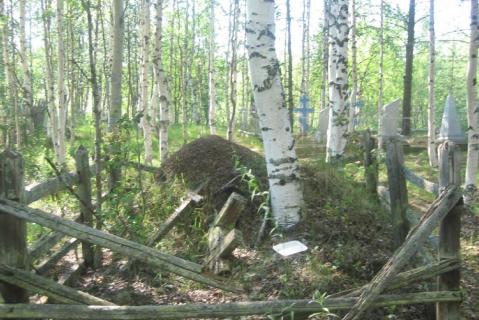The Peschanka special settlement was used to accommodate dekulakized peasant families from Northwest, South and Central Russia (Arkhangelsk, Vologda, Stalingrad (Volgograd) and Voronezh Regions). According to oral testimony, more than a thousand men, women and children died during the first three years. The cemetery was organised on the northern outskirts of Peschanka. The total number of forced settlers buried here is unknown.
Information about the deaths of particular individuals in the settlement is contained in a hand-written collection of memoirs by former inhabitants of Peschanka (the collection, assembled in 2003, is preserved in the Pechora museum of history and local studies). After the restrictions on the inhabitants were lifted in the mid-1950s, residents of the village were also buried in the same cemetery. Grave-markers from the 1930s-1950s are poorly preserved and no one is caring for the old graves.
Repentance: the Komi Republic Martyrology of the Victims of Mass Political Repression (11 vols. 1998-2016), includes entries on 65,000 individuals, from dekulakised peasant families and former Polish citizens to Soviet German forced labourers, who were deported to the area.
The Memorial online database (2025) lists 129,473 victims in the Komi Republic. (See Nizhny Chov.)
They include many families and individuals deported to the Republic, e.g., 20,366 during collectivisation (1929-35), 597 are listed as dying in Komi (but cf. Tomsk Region police figures).
The database lists families and individuals (total 1,322) deported to Peschanka, including some (129) first sent to Kadzherom, and 219 who were born in Peschanka. 942 were sent to the special settlement in 1930-1.
| State of burials | Area | Boundaries |
|---|---|---|
|
Subsidence over burials, grave mounds, several headboards have survived
|
About 4 hectares
|
Not delineated
|
[ Original texts & hyperlinks ]
“A Book of Remembrance of the Peschanka settlement: Recollections of former forced settlers / kulaks” (manuscript), Compilers T.G. Afanasyeva & G.M. Kaneva, 2003
“The cemetery of the Peschanka special settlement”, Virtual Museum of the Gulag [retrieved, 26 May 2022; no longer accessible]
*
Reply from Pechora urban district administration (No 01-14-6229 of 7 July 2014) to a formal enquiry by RIC Memorial (St Petersburg)

